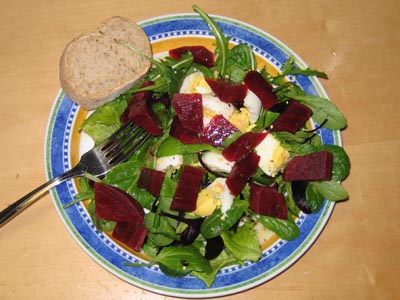Our first CSA drop-off of the year was yesterday (a week earlier than normal), and it’s a bumper year for greens. Our farmer tells prospective members to expect 5-7 items a week in a small share and 8-11 items a week in a large share. We get a large share, and this week we got 16 items! We’re feeling a bit inundated.
We got a small share for many years before upgrading to a large share 3 years ago. What made us change was the combination of learning how to freeze vegetables for winter use, and really wanting our local eating to be year-round. That was when I started this blog, to track how it went and share what we’d learned. I explained more in my first post.
Over the 7 years we’ve belonged to a CSA, we’ve learned how to prepare various obscure vegetables. We’ve found some new favorites, and found that favorites change depending on the year (growing conditions?) and the preparations we use. We’ve learned how to freeze vegetables (detailed in an earlier post), what freezes well (or what cooks well after being frozen), and how to predict how much of our bounty we should freeze (because we won’t get around to eating it fresh).
Which takes me to this week. There’s no way we can eat 16 bunches of greens in one week, at least not in any way that leaves us happy to repeat the process next week. And why should we? We very much enjoy our home-frozen greens when we eat them in January.
This week we got 2 bunches each of red leaf lettuce, bibb lettuce, and pea tendrils – none of which freeze. I’ve heard good things about romaine lettuce in stir-fries, but not bibb or red leaf. We’ll eat a lot of salad this week, but we’ll also revert to one of the best tricks for surplus: giving away at least 1 of our 5 heads of lettuce. Pea tendril leaves can be enjoyed raw in salads, or get cooked into stir-fries or any dish that uses peas, because the flavors are so similar. To do so, just pull the leaves off their vines. The flavor is so nice and de-leafing so time-consuming that we usually eat them as finger food, grabbing a stem and munching leaves, flowers, and the edible parts of the stem, until all that’s left are un-chewable parts for compost.
We also got 2 bunches each of bok choy, mizuna, chicory, kale, and spinach. If we didn’t have so much lettuce, we’d enjoy some of the spinach raw in salads. Mizuna and chicory can go into raw salads, adding interest with their strong flavors – mizuna is spicy and chicory is bitter – but only in small amounts.
Bok choy is generally a stir-fry green around here, but sometimes goes raw into cold peanut noodles. My peanut noodle sauce involves throwing stuff into a blender until I’m happy with the texture and flavor: peanut butter, sesame oil, soy sauce, rice vinegar, garlic, ginger paste, and chili oil. That gets tossed with the noodles while they’re still hot, and sometimes sesame seeds also. Sometimes I add the vegetables at the same time, so they get coated with sauce, but sometimes I add them later, so they don’t get wilty the hot noodles. Scallions, carrots, bok choy, napa cabbage, and romaine lettuce are all good peanut noodle vegetables.
Bok choy does not freeze, and mizuna (also a stir-fry green around here) does not freeze well, so I predict a few stir-fries in our future this week. They probably won’t go into stir-fries together, as they have affinities for different sauces. The bok choy will probably be joined by some of the turnips we still have in our refrigerator from last fall. Both mizuna and bok choy/turnips will be stir-fried with tofu cooked firm, something I should have learned to do much sooner than I did. The trick is to not use oil until after the tofu is browned! Cut the tofu into large bite-sized pieces, and arrange them on the bottom of a large non-stick skillet. Give them fairly high heat, and flip them over when the first side is browned. After the second side is browned, add whatever oil, sauces, and seasonings you like, and of course vegetables.
Because we got so much this week, and so many things that just don’t freeze, we then have to freeze whatever we can. This morning, I froze both bunches of kale and both bunches of chicory. Having now been through two winters of home-frozen vegetables, I have a much better sense of what’s worth freezing. Kale cooks almost as well from frozen as it does fresh. Chicory loses some of its texture – particularly its nice, crunch stems – but retains enough flavor and texture to be worth freezing. Now or next winter, you can cook it up with oil, garlic, lemon juice, and garbanzo or cannelini beans, to serve over couscous.
I have ambitious plans to turn the spinach into spanikopita filling, sort of a fritata, and freeze that (after baking). I’ve been good about following my doctor’s recommendation to not eat feta during pregnancy, so I’m sure I’ll enjoy spanikopita all the more after the birth.
